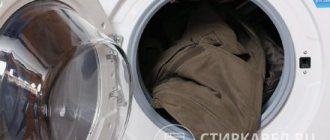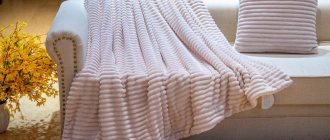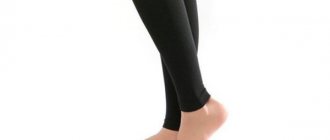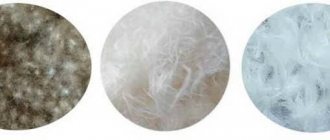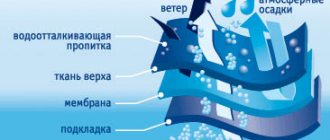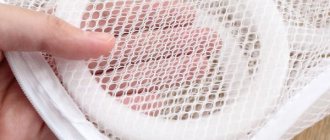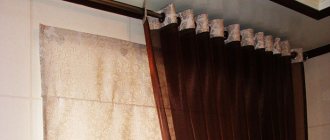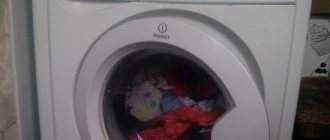How to wash in a washing machine
Washing curtains has its own characteristics and general rules. First of all, before washing, you need to determine what fabric the product is made of. The fabric of the product is the main recommendation on what mode to wash curtains. The basic rule here is: the thinner the fabric, the more gentle the regime should be. It is better to wash all thin or complex items that can be damaged in a fabric bag - this way they will retain their fresh appearance.
Textiles of a simple cut without additional finishing are easy to care for. The main condition for success is to choose the right processing mode.
Advice. When purchasing finished products, you should keep the label that is sewn to them. It contains all the necessary information about washing, cleaning and ironing modes.
It is important to note that all curtains shrink slightly after washing. Only products made of synthetic materials: polyester or nylon do not change their size. Linen shrinks the most, cotton fabrics shrink slightly in size. Silk and organza give minimal shrinkage.
To prevent unpleasant situations, it is advisable that the washing machine has a delicate mode or its equivalent and the ability to turn off the spin cycle.
Also, the design of the curtains also influences the question of what mode to wash curtains in an automatic machine. The easiest way to wash regular items is made from straight fabrics. Many people have questions about how to wash products with a complex structure: made of threads, Roman blinds or curtains with fasteners, for example, with eyelets. Models made of threads, with complex drapery or lambrequins should be washed and placed in a fabric bag before washing.
Before putting it into the machine, textile decor must be shaken out to reduce dust.
In this case, the rain must first be braided into a weak braid and tied with a rope in several places. This way the threads won't get tangled.
How to wash blackout curtains
Such curtains are characterized by a complete lack of light transmission, which makes it easy to darken the room if necessary. The material acquires such properties due to its multilayer structure. It is permissible to wash blackout curtains in a washing machine, unless the fabric has a metallic coating and an acrylic layer.
We recommend: How to wash a cashmere product at home and dry it properly?
After studying the label, you can find out exactly the composition of the product and decide on the method of caring for it. It is better to wash multi-layer fabric using gel, then there will definitely be no streaks left. After loading the curtains into the drum, set the temperature recommended by the manufacturer. As for the mode, a delicate wash with a spin cycle at minimum speed is suitable.
Preparatory stage
Any curtains must be prepared before washing. First, you just need to shake them out to remove excess dust and pet hair. It is better not to shake curtains with eyelets, but use a vacuum cleaner. To do this, you need to lay them out on a sofa or clean floor and go over them with a vacuum cleaner with a special furniture brush.
The temperature at which the curtains are washed determines how they will look in the future.
Then, if possible, remove all hard objects from the products, especially those that can come off: hooks, clips.
After this, the curtains must be inspected for:
- Possible damage.
- Stains or traces of grease.
- Pollution.
When loading fabric items into the washing machine drum, pay attention to which program they can be washed in.
Choose a gentle mode with minimal spin speed. Fabric products may have damage either at the fastening points or at the hem. If there are small tears, they should be sewn up first.
If dirt or greasy stains are found, it should be sewn with large stitches using any contrasting thread. After this, they are soaked for 30-60 minutes, then the stains are washed away. Do not rub thin fabric, as this can damage it. It is better to lift it out of the water several times and then go over the stains with a brush.
Important! When the fabric gets wet, the stains will no longer be visible. Therefore, they need to be marked with contrasting threads. After such preparation, you can move on to the main stage.
All detergents must be liquid. Powders are difficult to rinse out.
Mode selection
The mode for washing curtains is selected depending on the fabric. All products are washed separately from other items, and the machine should be loaded approximately halfway, since the curtains must move freely in the drum. It is important to check the weight of the products and the capabilities of the machine, since if you load an amount of fabric that the device is not designed for, it may break.
After loading the curtains, all that remains is to select the water temperature and mode. The water temperature is selected depending on the type of fabric:
- Up to 30 degrees - silk, veil or organza.
- 30 degrees for dyed linen.
- 30-40 degrees – acrylic, viscose, plain linen and colored cotton.
- 40-50 degrees - undyed cotton or taffeta.
The optimal choice is 30-40 degrees, otherwise the fabric may fade or become deformed.
Use only liquid products for each type of fabric. When determining which mode to wash curtains in an automatic machine, it is better to give preference to the most gentle option or choose “hand wash”. It is better not to use spinning for thin curtains in principle. For cotton and linen, spinning with a minimum number of revolutions is suitable.
Hand wash material
Manual washing of velvet is very simple:
- Warm water up to 30 degrees is poured into the basin,
- the product is completely turned inside out,
- washed out with gentle kneading movements, without rubbing, squeezing or twisting,
- such manipulations are carried out until the contamination completely disappears; if necessary, the water can be changed several times,
- for rinsing, use water at a temperature slightly lower than when washing,
- add a little apple cider vinegar to preserve the color of the outfit,
- Using gentle kneading movements, any remaining detergent is washed away.
Washing velvet by hand
The procedure is not complicated, but it is painstaking.
Washing depending on material and type
Each material and type of product also has its own small characteristics. In addition to the correct mode, there are several more secrets that will allow you not only to wash the curtains, but to maintain their appearance and not break the washing machine.
The temperature at which the curtains are washed determines how they will look in the future.
Blackout
Blackout curtains are usually made of thick fabric that provides complete blackout. They are often made of thick velvet or tapestry and have a relief pattern. Therefore, many people have a question: how to wash blackout curtains in a washing machine.
If blackout curtains are made of thick curtain fabric, for example, tapestry, then they will be very unpretentious in washing. They can be washed in any mode. For cotton material, you can choose a temperature of 50 degrees; for linen, it is better to set it to 40 degrees. In this case, the spin should be set to minimum.
Advice. You won’t be able to do without spinning at all, since these curtains absorb a lot of water, it will be quite difficult to remove them from the washing machine.
If blackout curtains are made of thick velvet, then they should be washed on a delicate cycle or with the “hand wash” option. It is better to set the temperature to 30 degrees. In this case, the fabric must be placed in a bag, folded in advance with the pile inward.
Curtains made from a special light-proof fabric - blackout - have received not only the name of the same name, but also great popularity.
It is also better not to wash thick velvet curtains at all, but to get by with dry treatment or take them to dry cleaning.
With eyelets
Eyelets in the fabric can cause damage to the washing machine and even break it. They can also become damaged, for example, crack during washing. Therefore, whenever possible, curtains with eyelets should be washed by hand.
If you still need to use the washing machine, then you need to try to remove the eyelets - some designs provide for this possibility. Plastic rings are usually easy to remove. If it was not possible to remove them, then they must be placed in the drum only in a protective fabric bag. It will protect the device parts and the eyelets themselves from damage.
The temperature for plastic eyelets should be set to 30 degrees, metal products can withstand 50 degrees. The mode is chosen to be gentle, and there is no need to squeeze them out.
If you have chintz curtains with eyelets, then remember that it is better to wash them by hand in slightly salted water with the addition of vinegar. This solution will make the pattern on the curtains brighter and more saturated.
With hooks or rings
Many people wonder whether it is possible to wash curtains with hooks and whether this will damage the hooks themselves and the washing machine. Indeed, hooks or rings are objects that can become damaged or damage parts of the washing machine. Therefore, it is better to remove them before washing. Plastic rings are usually easy to remove.
Iron hooks are most often sewn to the fabric or sewn into curtain tape. Therefore, most likely, they will have to be cut and then sewn again. Despite the fact that this is a very labor-intensive process that requires perseverance, the time spent will be rewarded handsomely. In this case, you will not have to repair the washing machine or buy new hooks.
If there is no way to remove the hooks, it is better to choose hand washing. Or, as a last resort, wash the curtains in a bag on a delicate cycle. But it is worth remembering that even such a wash will pose a serious risk to the curtains and parts of the washing machine.
Improper washing of curtains and lambrequins will damage the fabric and after this the curtain may look even worse than before washing.
Thread
Washing thread curtains is no different from cleaning ordinary products. The only caveat is that before putting them in the drum, the threads need to be braided into a weak braid, which is tied with a rope every 30-40 cm. It is also advisable to put the braid in a bag. These actions will protect the threads from damage, tangling and getting into machine parts.
The temperature and type of washing must be selected according to the material from which the threads are made. Spin is selected in the same way.
Such curtains need to be dried in two stages: first, let the braid drain by laying it on a board in the bathtub, sink or other similar place. This process usually takes 2-3 hours. During this time, the braid must be periodically turned over, shaken and lightly squeezed by hand. After the bulk of the water has drained, the curtains need to be hung. In this form they will dry completely.
To prevent tangling, which will hopelessly destroy the curtains, they must be divided into longitudinal parts and each in several places, along the entire length, tied with ribbons or ribbons. This must be done without removing the curtains from the curtain rod.
Linen
The main difficulty in washing linen curtains is their shrinkage. Flax tends to shrink the most. Therefore, you need to choose the minimum temperature - about 30 degrees. If the products are made of thick fabric, then the normal mode can be selected. For delicate fabrics such as cambric, choose delicate or hand washing.
For thick fabrics, you can set the spin cycle to minimum. After washing, they need to be hung on the dryer in several folds, and after drying, ironed with a regular iron.
Delicate cambric curtains cannot be wrung out even by hand - this will damage them. Before drying, they need to be folded in the bathtub or sink, allowing most of the water to drain. In this case, the fabric must be squeezed several times, but not twisted. After this, the curtains can be hung on the curtain rod. In this form, they will not only dry, but also smooth out.
Durable, wear-resistant fabrics. They withstand high-temperature intensive washing well.
With beads
The difficulty of processing products with beads, rhinestones, shells or other additional decor is that it can come off and get into the washing machine mechanism, which will damage it. Large decorative items, such as shells, may crack or break. Therefore, if possible, it is better to remove all such parts or simply wash such products only by hand.
If the beads are small and there are a lot of them, then the curtains can be washed in the machine in a bag. The temperature is set to 30-40 degrees depending on the material. The automatic mode must be selected “hand wash”.
The bag will not save items with large decor, so it is better to wash them only by hand.
Models with small beads can be squeezed out by hand, but it is important not to twist them. Products with sharp or large decorative elements should not be wrung out, as this may damage the fabric. The material should be allowed to drain and then carefully hung on a curtain rod to dry.
Important! These curtains must be hung when damp. This way they will smooth out on their own. It is impossible to iron such products with an iron.
Beaded curtains look impressive in any room, but require very careful washing.
Curtains
Curtains are made from thin, delicate fabrics: silk, cambric, organza. Therefore, they require additional delicacy when processing. It is better to wash such products in the following ways:
- With your hands.
- In an automatic machine on the “hand wash” mode.
- Be sure to use a fabric bag.
When washing curtains by hand, do not rub them, as this may damage the fabric. The use of chemical bleaches is not recommended for this material, as they are quite aggressive on the fibers and can damage them.
When washing in a machine, set the temperature to 30 degrees, and select manual mode.
When washing by hand, the nylon is simply soaked in a container with soapy water, left for a couple of hours, then carefully, without twisting, rinsed and hung to let the water drain.
Under no circumstances should you wring out delicate curtains. When washing in an automatic machine, they must be allowed to rest in the drum so that the water drains. Next, they need to be laid out in a sink or bathtub, allowing most of the water to drain. After this, the thin fabric needs to be hung on the cornice.
It is not recommended to hang curtains to dry, as when drying, creases form, which will then be difficult to remove.
Wash the veil folded, placing it in the machine as a roll or using a special laundry bag.
Laundry for “window clothes”
Thick fabrics, drapes and curtains.
- Linen. Linen curtains tolerate hot water well; for undyed ones, you can raise the heat to 95°. If they are painted, no more than 60° is sufficient. Products with embroidery and bright printed patterns can withstand heating up to 40 degrees. It is better not to wring curtains made of linen fabric in the washing machine, as they are prone to severe wrinkles.
A delicate regime is needed.
- Cotton. A special program is provided for cotton products, and it must be followed. For colored ones, heating is allowed within 60°; if the designs are bright and printed, there is embroidery, then no more than 40°. You can spin them at maximum speed.
No delicate wash required.
- Matting. Washing products made from matting can be carried out in any mode, but the temperature should be set to no more than 30 degrees.
Spinning is not recommended.
- Taffeta, satin brocade and other dense fabrics with a glossy surface. Such fabrics are washed at a temperature of no more than 50°, if there are patterns - no more than 30°. Spinning is not recommended, as they are prone to creases.
The washing mode is delicate.
- It is better to dry clean velvet, velor, tapestry, jacquard, gabardine and other heavy curtains. In case of emergency, when machine washing, the water temperature should not exceed 30°. For velvet and velor, soaking is not recommended; machine washing is permissible for no more than half an hour; the fabric should be loaded into the drum, folded with the pile inward.
Turn on the delicate mode; you cannot squeeze them.
Important! Before washing items made from dense fabric, it is advisable to find out whether it has been decatified. This is a procedure for forced shrinkage of fabrics, which is carried out before cutting and sewing. On factory products, this information may be present on the label; if the products are designer, you can ask the manufacturer about decatification. If finding out is not possible, wash them for up to half an hour, in the coolest water and avoid spinning.
Lightweight fabrics, curtains
- Organza, semi-organza, voile, silk. It is advisable to wash them in individual bags so as not to damage the delicate fabric. We set the mode to manual, heating no more than 40°. We'll set the time to half an hour.
They should not be squeezed out.
- Acrylic, viscose. They must be washed using a delicate program at a temperature of no more than 40 degrees. It is recommended to add conditioner to the special compartment to prevent the item from becoming rough.
Spinning is contraindicated.
- Tulle, nylon, nylon. It is advisable to place the tulle in a special bag before placing it in the drum. The water temperature for these things must be set to a minimum, no more than 40°. Powders or shampoos that provide minimal foaming are suitable here.
The mode is only allowed manually; you should not press it under any circumstances.
- Polyester. The mode is only delicate, degrees no more than 40 to prevent the appearance of wrinkles. Minimal addition of detergents and thorough rinsing are necessary to avoid streaks.
Spinning is contraindicated.
From threads and ropes
Thread and rope curtains have their own preparation characteristics. Before loading such specimens into the washing machine, it is necessary to prepare them by tying them in several places with twine to avoid tangling of the threads. You can also braid threads and rope suspension into loose braids.
The weaving or tying procedure can be carried out before removing the curtains from the curtain rod.
After that, put them in a special bag. The mode here must be set manually, the temperature should not exceed 30°. Squeezing them out is strictly contraindicated. It is advisable to take detergents that form a minimal amount of foam.
After removal from the drum, they must be immediately hung on the curtain rod to avoid loss of shape and uneven edges.
Note! It is advisable to place curtains made of lightweight materials in the washing machine in special bags to prevent deformation. Such bags are sold in hardware departments. They can be used repeatedly.
Blackout curtains
The blackout standard fabric is made on a polyester base and has a double satin weave. Thanks to its properties, it provides complete darkness in the room, as well as soundproofing and retains heat. These curtains provide excellent protection from light and extraneous sounds, so they are best used in the bedroom or children's room.
This material is very resistant to fading and stains.
In a washing machine, blackout curtains can be washed in any mode and at high temperatures, and can also be pressed at maximum speed, if the composition does not contain a metallized coating or an acrylic layer.
In this case, washing is allowed no higher than 40° on a delicate cycle; wringing is not recommended.
Note! Drying most types of curtains in washing machines is not recommended. After washing, it is permissible to hang light curtains immediately on the curtain rod, so they dry quickly and do not lose their shape. Other types of curtains are hung in a place where there is no direct sunlight to drain excess water.
Washing curtains with hooks
It is not recommended to load curtains with hooks that have not been removed into washing machines, as they may come loose during the process and get into the filter or other important components of the device, or get stuck in the sealing rubber bands or in the holes of the drum, which will lead to tears and damage to the fabric.
In cases where there is no other way out, the curtain with hooks is placed in a special bag, additionally securing the edge on which the hooks are located with twine.
Important! The washing machine must be loaded at a volume slightly more than half the weight specified in the instructions for this model. Combination with any other items is unacceptable.
Can it be washed by hand?
Complex designs with hooks, eyelets or rich decor, as well as delicate items, are best washed by hand only. This is the simplest and most reliable way not to break the automatic machine and protect the curtains from damage.
However, many housewives look at this option with fear, because they are afraid of rubbing their hands or hurting their back. By knowing simple secrets, these unpleasant moments can be avoided.
To choose the right powder and bleach, consider the manufacturer's recommendations for fabric care. The label usually indicates at what temperature the tulle should be washed and the possibility of bleaching with chemicals.
The curtain fabric does not need to be rubbed. To remove dirt and stains, you just need to repeatedly dip the curtains in water and remove them from there. Difficult stains can be scrubbed off with a brush.
It is better to place a basin of water on some elevation: a table or board in the bathroom. This will avoid repeated bending of the back and overload of the lower back. It is better not to use a bathtub for washing due to the high probability of injuring your back.
The cleaning regime determines not only the composition of the fabric, but also the finish of the product.
You need to wring out the curtains only by squeezing them slightly. The water should be allowed to drain for 2-3 hours.
Important! Do not twist the fabric when squeezing! This will lead to its deformation.
After the water has drained, the curtains can be hung to dry or directly on the curtain rod.
Rules for washing velvet products
Before washing, for example, a velvet jacket or cardigan, be sure to study the manufacturer's tag or label. It is there that contains comprehensive information about caring for this matter.
You also need to look at the information on the label in order to make sure that the purchased fabric does not belong to the type of material for which water procedures are generally contraindicated.
An example would be viscose or silk velvet. Once wet, it completely loses its structure. These types of expensive fabric can only be washed by dry cleaning or dry cleaning.
Synthetic and cotton velvet can only be washed by hand or delicately washed in an automatic machine. Any type of this fabric requires the most gentle and careful heat treatment with water. You only need to wash it from the wrong side.
This is how soft fibers retain their appearance for a long time. Active friction and twisting of the material should not be allowed. When choosing a machine wash mode, you should give preference to gentle washing of delicate fabrics. Drying and spinning velvet in an automatic machine is strictly contraindicated.
Velvet
Among the detergents there should not be dry bulk powders. Capricious hair loves liquid and gel products without bleaching components or aggressive substances.
It is ideal if the machine wash mode allows you not to change the water temperature, because it should remain in the range of 30 to 35 degrees. This way the elasticity of matter will not be impaired. Frequent changes in temperature during the washing process spoil elite fabric.
To prevent colored items made from this material from fading, you should add apple cider vinegar while rinsing. This will preserve the shine of the pile and the richness of the color.
ARTICLE FOR YOU
How to wash chiffon correctly: in the washing machine and by hand
Removing difficult stains
If stains from grease, ink, paint or other difficult-to-remove substances have formed on the fabric, these stains must first be cleaned.
Some fabrics are strictly prohibited from being washed in any way, even by hand. They are taken to the dry cleaner.
Important! For thin or colored materials, do not use aggressive chemicals. They can damage patterns on colored fabrics or corrode the fibers of thin fabrics.
To remove difficult stains, it is better to use home remedies:
- Salt.
- Soda.
- Soda and vinegar.
- Citric acid.
- Hydrogen peroxide.
For fabrics with a pattern, salt, soda, and vinegar are suitable. Light-colored fabrics can be cleaned with lemon juice or citric acid. It is better to treat delicate fibers with salt.
To remove stains, you must first lightly moisten the stained area, then remove the dirt, and only then soak and wash the curtains.
Don't wait for the curtains to turn yellow or gray with dust. Wash them at the first sign of soiling. This way you will preserve their color and dense structure for a long time.
Drying curtains
There are three ways to dry such bulky items:
- Pre-place it in a container or on a surface from which water can drain. This will greatly facilitate further manipulations with heavy, wet curtains.
- Hang to dry in several folds. This method is quite convenient, but will require subsequent ironing.
- Hang wet curtains directly on the curtain rod. It is important to ensure that water does not drip onto the floor and damage the floor covering. This method avoids ironing.
Forget about automatic spinning and do not unscrew the curtains by hand.
Just hang them up after washing and let the water drain naturally. This will keep the fabric even and smooth. It will not have treacherous creases that are very difficult to iron out. Thin fabrics and models with decor are usually immediately hung on a curtain rod, as they are difficult or impossible to iron.
On the contrary, it is better to let dense fabrics hang to dry first and then iron them. It will be difficult to immediately hang thick, heavy curtains on the cornice.
Washing curtains with eyelets
What if the curtains have eyelets? Don't be alarmed, these products are all durable and practical, and the rings are strong and can withstand loads reliably.
High-quality and simple eyelets, as a rule, require washing along with the curtain
Another thing is eyelets with decor - such products must be removed before washing the curtains
Place the curtain in a washing bag without removing the eyelets; it will protect the coating of the drum and ring from scratches and chips. Do not leave the curtain in the bag for a long time after the machine has stopped working - the parts may turn pale and the material may lose its shape. It is advisable to choose a gentle mode, delicate or hand wash, setting the temperature to 30 ° C.
Not only curtains with eyelets, but also curtains with any decorative elements can be washed in a cover. This way the curtain itself, the decorations and the drum of the machine are preserved.
Use liquid gel or regular shampoo, do not use washing powder. It is abrasive and may leave small scratches. When rinsing, add fabric softener to soften the fabric, making the fabric soft and elastic to the touch.
Liquid products are gentler and more effective
You should only remove the rings if they are made of cheap, simple plastic and you are not sure that their appearance will not be affected. There are curtains on sale with a removable grommet strip; this is an additional convenience and helps to avoid damage to the rings.
Ironing rules
You can only iron items made of thick, smooth fabric. You can't iron:
- Thin curtains.
- Products decorated with beads and rhinestones.
- Curtains made of threads.
- Velvet models.
Curtains are washed as they become dirty; the standard interval between washes is usually six months.
However, the period between washes can be much shorter if you live in a big city, or if your windows face a busy street with constant traffic. The heating temperature of the iron is selected according to the fabric, but it is better to turn on the steam mode. Steam will allow you to iron your curtains faster.
Ironing option - steaming curtains while hanging, if the design of the iron allows it. To process steam by weight, you need to select the “steam release” mode.
Items that cannot be ironed should be hung immediately. If this is not planned, then they can be dried in the usual way, then folded and put away. The creases and wrinkles that form in this case can be eliminated later by moistening and hanging the curtains.
If tulle is used as curtains, due to its large size, it is difficult to clean them by hand. It is logical to wash it in a machine. Modern machines provide the functions “Hand Wash”, “Delicate Wash”, “Curtains”, “Silk”.
Another option for ironing curtains that have already dried is to steam them while hanging and let them dry.
Dry cleaning
If you are afraid of ruining your curtains by washing them at home, trust the professionals
Dry cleaning is often chosen by owners of luxurious, expensive curtains made from natural materials. If you live in your own home, where every window is decorated with expensive curtains, then dry cleaning is your option. Specialists from the cleaning service currently provide not only cleaning services, but also help to remove and hang them back. There is also an in-home dry cleaning option. In this case, professionals will clean them without removing them from the curtain rod.
Always contact only trusted cleaning services. Study the manufacturer's labels on your curtains yourself to find out whether dry cleaning is allowed for this type of fabric, and whether it can be cleaned using aqueous solvents. Discuss cleaning methods in advance so that the entire procedure is as successful as possible.
How to wash without ironing
To reduce the risk of subjecting the fabric to harsh heat treatment, you can wash it so as not to iron it later. Typically this method is used for velvet or thin tulle.
The procedure for such washing:
- Fill the bath with a little water, about 5-10 cm at the bottom.
- Pour in detergent previously diluted in water and stir.
- Carefully fold the curtains along their length into several layers.
- Lay the curtains at the bottom of the bath and submerge them in the water.
- Brush the curtains on several sides.
- Drain the water from the bathtub, leaving the curtains lying at the bottom.
- Fill and drain clean water several times, gently rinsing the fabrics in it.
- Finally drain the water from the bath, leaving the canvas lying at the bottom.
- After 30-40 minutes, lift the curtains and let the water drain.
- Leave the fabric on the bottom of the bath again and repeat the procedure 2-3 times.
- At the end you can hang damp curtains. Alternatively, the fabric can be allowed to dry completely in the bath and then removed. To do this, you need to shake it off and turn it over regularly until it dries completely.
To iron curtains with an iron, you need to set the device to an extremely low temperature.
Basic recommendations
Let's try to summarize everything said above and list everything that is required for proper care of curtains, regardless of the type and size of the window leaf.
- Study what is written on the tag and follow the instructions.
- Make sure you know exactly the composition of the fabric and are sure that they can be put into the machine. Also check to see if the decorative elements are damaged.
- Do not fill the machine drum tightly, otherwise contaminated areas will remain and the cloth will not be rinsed completely. This will lead to streaks on the curtain. If the size of the panels is very large, then it is better to wash one at a time and include an additional rinse.
When the drum is half loaded, the fabric is washed better and rinses well - Do not use solid powder, but shampoo or liquid gel. This will prevent damage to the fibers. Special bleaching agents have been developed for white curtains.
- Be sure to use a washing bag, this will protect the tank of the machine and the curtains themselves from being pulled in, and will prevent damage to the decor.
- Do not place any items with the curtains. Leave only the curtains and nothing else.
- Turn off the centrifuge; spinning causes creases and damage. Allow the water to drain on its own.
- Washing in a washing machine is much easier than washing by hand and makes life easier for housewives.
If you follow the fabric care recommendations, the life of the curtains is extended, and washing becomes simple and effective.
Do you doubt whether you should do your own laundry? Invite experts to your apartment for consultation. Now there are companies that provide such services at home; you won’t need to carry heavy curtains yourself.
